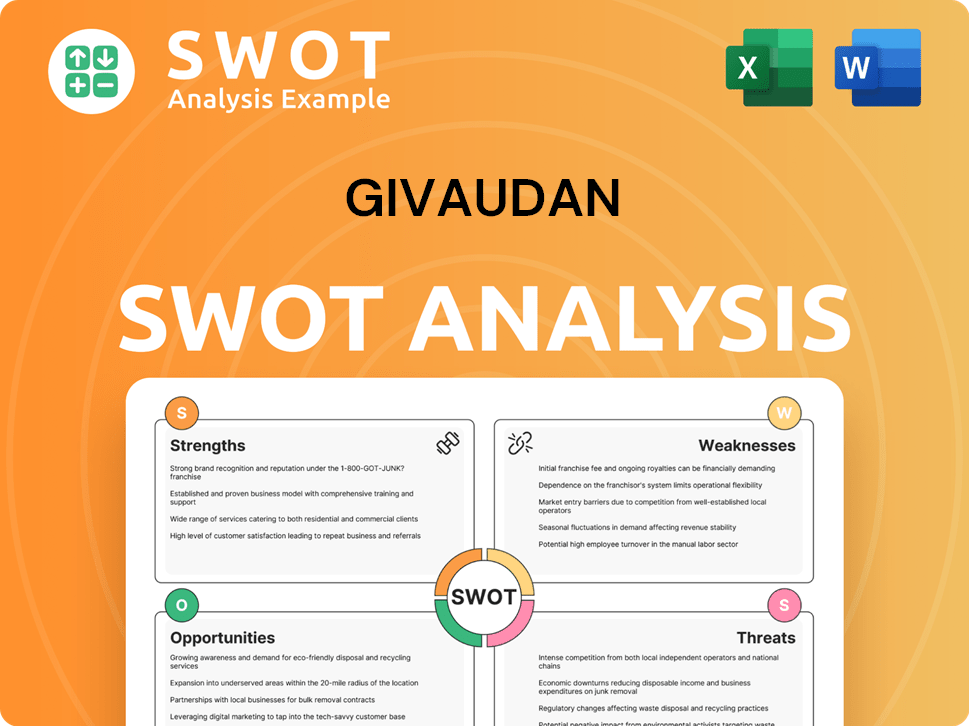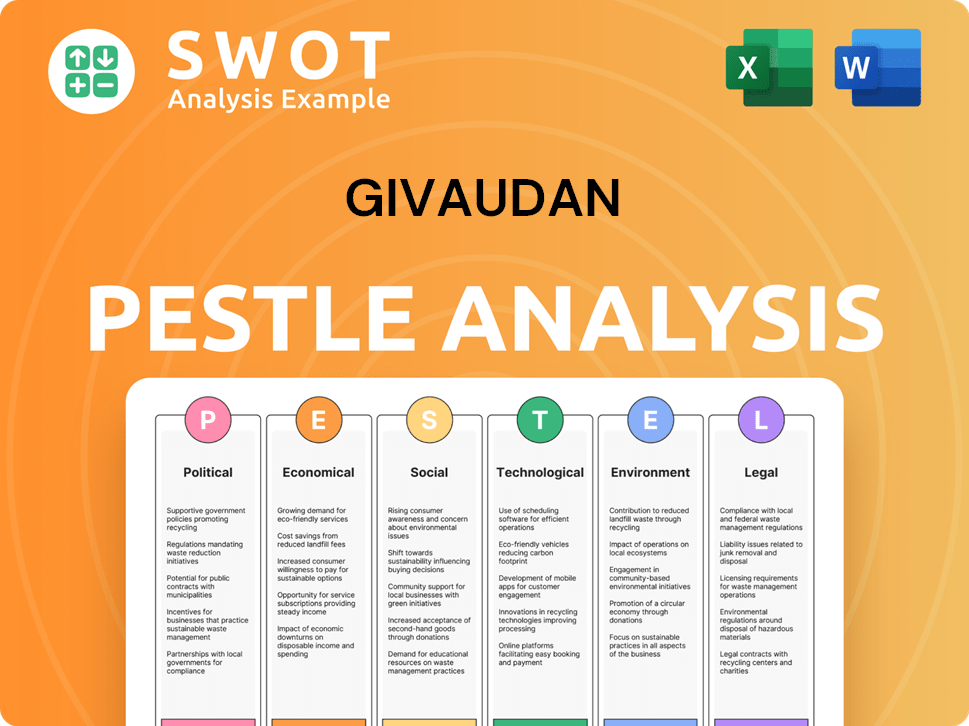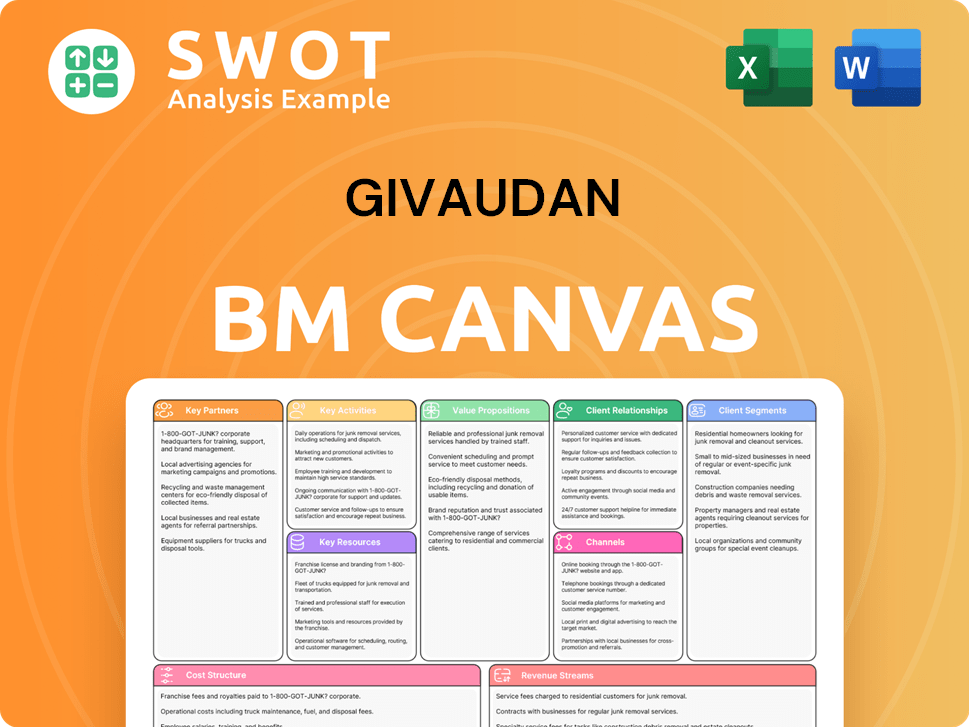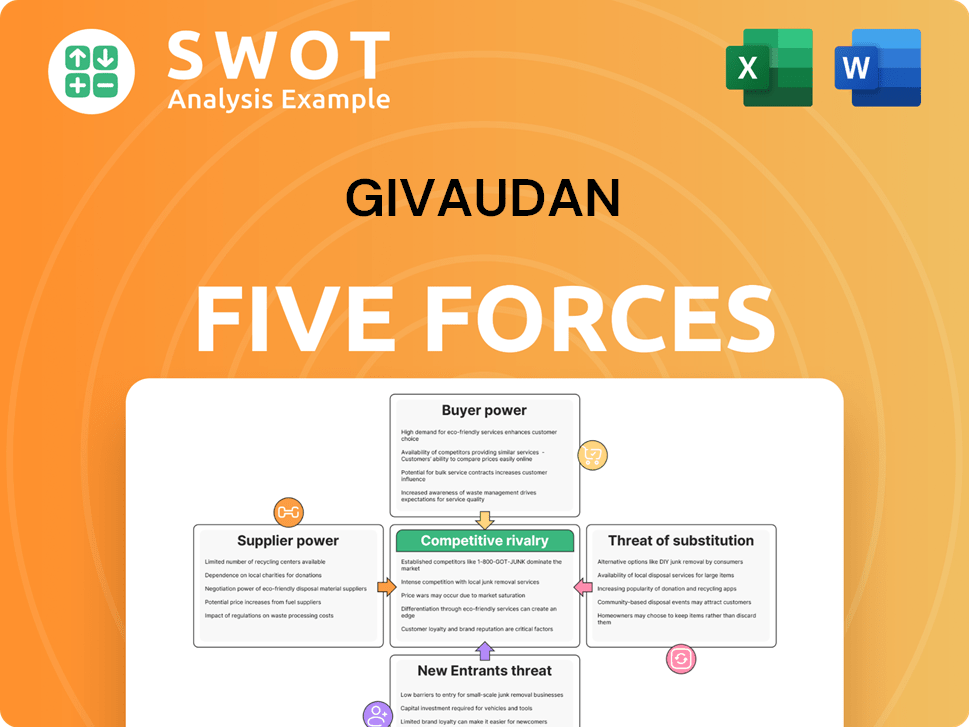Givaudan Bundle
How Does Givaudan Captivate Its Global Customer Base?
Givaudan, a titan in the flavors and fragrances industry, thrives by deeply understanding its Givaudan SWOT Analysiscustomer demographics and target market. Their success hinges on anticipating and fulfilling the evolving needs of consumers worldwide. This strategic focus is critical, especially with the rising demand for natural ingredients, a trend Givaudan is expertly navigating.

This exploration dives into Givaudan's customer profile, revealing how they segment their market and cater to diverse needs. We'll examine Givaudan's target market, geographical distribution, and the strategies they employ for customer acquisition and retention. Understanding Givaudan's market analysis and consumer insights offers valuable lessons for any business aiming to thrive in a competitive global landscape, particularly within the dynamic fragrance industry.
Who Are Givaudan’s Main Customers?
Understanding the customer demographics of the company involves recognizing its Business-to-Business (B2B) operational model. The company's target market primarily consists of major players in the food, beverage, consumer product, and fragrance industries. This approach allows the company to focus on the specific needs of its clients, rather than individual consumer demographics.
The company's customer profile is defined by the industries and product categories its clients operate within. Key areas include flavors for various food and beverage products and fragrances for personal care and household items. This strategic focus enables the company to tailor its offerings to meet the diverse needs of its B2B clients effectively.
The company's customer segmentation strategies are centered around its two main divisions: Flavors and Fragrances. In 2024, Flavors accounted for 50.6% of the net sales, while Fragrances represented 49.4%. This division allows the company to target specific segments within the broader consumer market, such as the food and beverage industry and the personal care sector.
The company's customer base is largely segmented by product categories. Flavors are used in savory products, beverages, sweet goods, and dairy items. Fragrances are used in cosmetic products, cleaning products, and fine fragrances.
The company's target audience includes major food and beverage companies, consumer product manufacturers, and fragrance houses. This segmentation helps the company tailor its products and services to the specific needs of each industry.
The company serves both large international and global customers and smaller, local brands. This approach allows the company to capture a wide range of market opportunities. The company has observed exceptional performance among local and regional customers in 2024.
The company's global presence allows it to serve customers worldwide. The company has demonstrated strong growth across all geographies in 2024. The company's market share by region is a key factor in its overall success.
The company's customer acquisition strategies involve focusing on both established and emerging brands. The company's B2B customer relationships are crucial for its sustained success. The company's target market for fine fragrances and other products is constantly evolving, requiring continuous adaptation.
- The company's customer needs and preferences are assessed through market research reports.
- The company's competitive landscape analysis helps it understand its position in the market.
- The company's customer retention strategies include providing high-quality products and services.
- The company's customer demographics in Asia and other regions are key areas of focus.
The company's commitment to innovation and expansion, as highlighted in the Growth Strategy of Givaudan, is evident in its strategic acquisitions and focus on emerging market trends. This approach enables the company to meet the evolving demands of its diverse customer base while maintaining a strong position in the global flavors and fragrances market.
Givaudan SWOT Analysis
- Complete SWOT Breakdown
- Fully Customizable
- Editable in Excel & Word
- Professional Formatting
- Investor-Ready Format

What Do Givaudan’s Customers Want?
Understanding the customer needs and preferences is crucial for companies like Givaudan, which operates in the flavors and fragrances industry. The primary focus is on aligning with the evolving demands of the end consumers who purchase products from Givaudan's business clients. This approach allows Givaudan to maintain a competitive edge and meet the demands of its target market.
The changing preferences of consumers, such as a demand for natural and sustainable products, significantly influence Givaudan's strategy. This includes a strong emphasis on research and development to create innovative solutions that meet these evolving needs. Givaudan's ability to anticipate and respond to these trends is a key factor in its success and customer loyalty.
Givaudan's customer profile is primarily defined by businesses within the food, beverage, consumer product, and fragrance sectors. These customers are heavily influenced by the end-consumer's desire for products that support health, wellbeing, and ethical business practices. Givaudan tailors its offerings to meet these demands, expanding its portfolio to include solutions for sugar reduction, alternative dairy, and vegan options.
Consumers increasingly seek natural and organic ingredients in their products. This trend drives brands to use essential oils, botanical extracts, and biodegradable compounds. Givaudan responds by investing in research and development for natural fragrance ingredients, such as the 'House of Naturals' initiative.
Purchasing behaviors are influenced by the desire for products that support health and wellbeing. This includes products that promote positive aging and align with changing lifestyles. Givaudan expands its portfolio beyond traditional flavors and fragrances to include nutrition and food ingredients.
Consumers expect ethical and responsible business practices. Givaudan addresses this by developing sustainable solutions and expanding its offerings to meet these expectations. This includes focusing on areas like sugar reduction and vegan options.
Givaudan's success relies on providing creative, innovative, and sustainable solutions. Their robust innovation capabilities and high winning rates against peers demonstrate their ability to deliver on customer briefs. This approach allows for price increases and supports growth momentum.
Givaudan leverages digital tools to support sustainable growth. This includes providing an efficient digital business service model for its customers. Their 'Guardians of Memories' project, launched in January 2025, aims to enhance consumer interaction and create memorable experiences.
Givaudan proactively addresses regulatory changes, such as new EU regulations on primary smoke flavorings taking effect in 2026. They offer a full toolkit of smoke-free ingredients to their customers. This ensures that their customers can comply with regulations.
Customer loyalty is built on Givaudan's ability to provide creative, innovative, and sustainable solutions. The company's ability to deliver on customer briefs allows for price increases and supports growth momentum. Owners & Shareholders of Givaudan benefit from these strategies.
- Innovation: Givaudan's robust innovation capabilities and high winning rates against peers.
- Sustainability: Providing sustainable solutions that resonate with consumers.
- Regulatory Compliance: Addressing and adapting to new regulations, such as smoke flavoring rules.
- Digital Engagement: Leveraging digital tools and insights to enhance customer service and support sustainable growth.
Givaudan PESTLE Analysis
- Covers All 6 PESTLE Categories
- No Research Needed – Save Hours of Work
- Built by Experts, Trusted by Consultants
- Instant Download, Ready to Use
- 100% Editable, Fully Customizable

Where does Givaudan operate?
The geographical market presence of the company is a key factor in understanding its customer demographics and target market. As of December 31, 2024, the company has a significant global footprint with 162 locations worldwide, including 78 production sites. This extensive network supports its diverse customer base and allows for localized strategies to meet specific regional needs.
In 2024, the company's net sales were distributed across various regions, demonstrating its global reach. These figures highlight the company's strong presence in both established and emerging markets, reflecting its strategic focus on worldwide expansion. The company's ability to adapt to local preferences and trends is crucial for maintaining its competitive edge in the fragrance industry.
The company's strategy focuses on maximizing opportunities in mature markets while expanding its presence in high-growth markets, especially in China. High-growth markets, including Asia Pacific, Latin America, and Eastern Europe, accounted for 47% of the company's annual sales in 2024. These markets are experiencing significant growth due to urbanization, changing lifestyles, and rising disposable incomes, making them crucial for the company's future success. Understanding the customer demographics in these regions is essential for tailoring products and marketing efforts effectively.
The company's net sales in 2024 were geographically distributed as follows: Switzerland (1.2%), Europe (28.9%), Asia-Pacific (20.8%), North America (23.4%), Latin America (11.8%), and Africa and the Middle East (13.9%).
High-growth markets grew at 19.5% on a like-for-like basis in 2024, while mature markets grew at 6.4%. This demonstrates the company's successful expansion into regions with high potential for growth. This growth is driven by factors such as urbanization, changing lifestyles, and rising disposable incomes.
Latin America experienced the largest increase in organic sales in 2024, with a 27.3% like-for-like increase. South Asia, Africa, and the Middle East also showed significant growth at 20.9% like-for-like. These regions are key areas for the company's future expansion and understanding the customer needs and preferences is critical.
The opening of L'Appartement 125, a new Fine Fragrance Creative Center in Shanghai, China, supports Chinese brands and provides insights into the latest trends. The company has also expanded its digital presence in China by partnering with Tmall and joining Alibaba's B2B platform 1688, demonstrating its commitment to leveraging digital innovation. For more information, you can read a Brief History of Givaudan.
Givaudan Business Model Canvas
- Complete 9-Block Business Model Canvas
- Effortlessly Communicate Your Business Strategy
- Investor-Ready BMC Format
- 100% Editable and Customizable
- Clear and Structured Layout

How Does Givaudan Win & Keep Customers?
Customer acquisition and retention strategies at Givaudan are integral to its growth strategy, which focuses on collaborative growth and delivering innovative solutions. The company's approach is centered on building strong business-to-business (B2B) relationships, offering tailored solutions, and expanding into new markets to meet evolving consumer demands. This strategy helps Givaudan to attract and retain customers effectively.
Givaudan leverages its robust innovation capabilities to attract and retain customers, consistently delivering on customer briefs and maintaining solid winning rates against competitors. The company emphasizes strategic partnerships and co-creation with customers, suppliers, and start-ups to develop innovative solutions. Digitalization plays a crucial role in their acquisition and retention efforts, providing an extensive and efficient digital business service model.
The company's commitment to sustainability and responsible practices, which are increasingly important to their customers and end-consumers, further supports customer retention. This focus aligns with customer values and helps them stay competitive. Givaudan's consistent financial performance and commitment to shareholder value, demonstrated by its 24th consecutive dividend increase in 2024, also contribute to a strong business reputation that aids in long-term customer relationships.
Givaudan expands its portfolio beyond traditional flavors and fragrances into nutrition, food ingredients, and beauty. This helps customers respond to evolving consumer demands for health and wellbeing. The 2024 acquisition of b.kolormakeup & skincare enhances capabilities in makeup and skincare, offering more complete solutions for B2B customers.
Givaudan consistently delivers on customer briefs and maintains high winning rates. Their focus on innovation is critical for creating differentiating solutions. For example, developing new sugar reduction ingredients and plant-based food solutions directly addresses changing consumer preferences, supporting customer product development.
Givaudan emphasizes strategic relationships and co-creation with customers, suppliers, and start-ups. They drive growth in the local and regional customer segment. This approach helps develop innovative solutions and expand market reach. Digitalization, such as their partnership with Tmall, is also crucial.
Customer retention is supported by Givaudan's commitment to sustainability and responsible practices. Their focus on sustainable sourcing and environmental targets aligns with customer values. Givaudan aims for climate-positive operations before 2050, enhancing their long-term customer relationships.
Givaudan's focus on B2B relationships and tailored solutions is a key aspect of its customer acquisition strategy. The company's customer profile includes businesses in the food and beverage, personal care, and fragrance industries. Givaudan's market analysis reveals a strong demand for innovative and sustainable ingredients, driving its expansion into new areas. The company's 2024 financial results, including a 24th consecutive dividend increase, demonstrate its commitment to shareholder value and contribute to strong customer relationships. For more insights, see the Competitors Landscape of Givaudan.
Givaudan segments its customers based on industry, product needs, and geographic location. This allows for tailored solutions and targeted marketing efforts. The company focuses on key consumer segments to maximize market penetration and customer satisfaction.
The primary target market includes food and beverage manufacturers, personal care brands, and fragrance companies. Givaudan's target audience for flavors and fragrances is broad, catering to diverse consumer preferences. The company's B2B customer relationships are crucial for achieving its goals.
Givaudan addresses customer needs by offering innovative and sustainable solutions. Customer preferences include health, wellness, and environmental responsibility. The company's market research reports help in understanding these needs and adapting its offerings accordingly.
Givaudan's market share varies by region, with a strong presence in Asia and Europe. The company's focus on innovation and customer relationships helps maintain its competitive edge. Givaudan's market share growth is supported by its strategic acquisitions and partnerships.
Givaudan employs several customer acquisition strategies, including expanding its product portfolio and strategic partnerships. Digitalization and co-creation with customers are also key. These strategies are designed to attract new customers and enhance market presence.
Givaudan's customer base includes major players in the food, beverage, and personal care industries. The company's B2B customer relationships are built on trust and mutual growth. Givaudan's customer demographics in Asia are growing, reflecting its global reach.
Givaudan Porter's Five Forces Analysis
- Covers All 5 Competitive Forces in Detail
- Structured for Consultants, Students, and Founders
- 100% Editable in Microsoft Word & Excel
- Instant Digital Download – Use Immediately
- Compatible with Mac & PC – Fully Unlocked

Related Blogs
- What are Mission Vision & Core Values of Givaudan Company?
- What is Competitive Landscape of Givaudan Company?
- What is Growth Strategy and Future Prospects of Givaudan Company?
- How Does Givaudan Company Work?
- What is Sales and Marketing Strategy of Givaudan Company?
- What is Brief History of Givaudan Company?
- Who Owns Givaudan Company?
Disclaimer
All information, articles, and product details provided on this website are for general informational and educational purposes only. We do not claim any ownership over, nor do we intend to infringe upon, any trademarks, copyrights, logos, brand names, or other intellectual property mentioned or depicted on this site. Such intellectual property remains the property of its respective owners, and any references here are made solely for identification or informational purposes, without implying any affiliation, endorsement, or partnership.
We make no representations or warranties, express or implied, regarding the accuracy, completeness, or suitability of any content or products presented. Nothing on this website should be construed as legal, tax, investment, financial, medical, or other professional advice. In addition, no part of this site—including articles or product references—constitutes a solicitation, recommendation, endorsement, advertisement, or offer to buy or sell any securities, franchises, or other financial instruments, particularly in jurisdictions where such activity would be unlawful.
All content is of a general nature and may not address the specific circumstances of any individual or entity. It is not a substitute for professional advice or services. Any actions you take based on the information provided here are strictly at your own risk. You accept full responsibility for any decisions or outcomes arising from your use of this website and agree to release us from any liability in connection with your use of, or reliance upon, the content or products found herein.